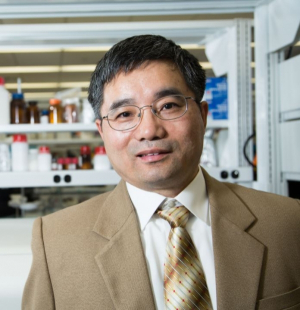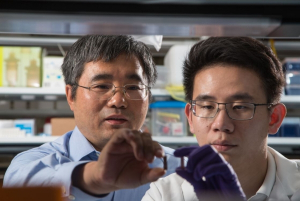Tianfu Wu used to dream of the day when cancer could be detected long before it was diagnosed. Now he sees that day dawning because of a system his research group created called the ultrasensitive polymeric sensing system (UPSS), which may detect biomarkers early – well before an illness strikes.
Wu, assistant professor of biomedical engineering, recalls a handful of years ago when he would chat with a colleague now and again on a train as they commuted to work. “She was in great condition, very active,” said Wu.
“And then one day, within a couple of months, as if out of nowhere, I received an email that her funeral was being planned and she had died of pancreatic cancer. It seemed that quick.”
The experience cemented his goal. “We want something for early biomarker detection, an ultra-sensitive biosensor” said Wu.
And now he has it.
You can read about the UPSS, composed of gold nanoparticle (gNP)-decorated polymer in Advanced Materials (with a current impact factor of 19.791), which published the article about Wu’s experiments with the UPSS. One of Wu’s Ph.D students, Zuan-Tao Lin, is the leading author of “A nanoparticle-decorated biomolecule-responsive polymer enables robust signaling cascade for biosensing.”
Multi-purpose tool
Wu’s device can also detect the level of toxins in environmental samples.
“The early detection of pathogens, biomarkers or toxins in clinical or environmental samples is a great challenge, especially at ultralow concentrations,” said Wu.
Conventional technologies using chain reactions or mass spectrometry are tedious and time consuming so there is an increasing demand to develop the rapid-sensing strategy. “We are developing an ultra-sensitive device to detect biomolecules that could be biomarkers for disease or could be environmental toxins in fresh water,” said Wu.
Using the UPSS Wu and his students tested Anatoxin- a, which can be secreted into water by blue-green algae.
It’s small and usually the concentration is low in water, only trace amounts exist. But don’t let that innocuous description fool you. Anatoxin-a is also known as “Very Fast Death Factor” (VFDF).
“It can have a very bad cumulative effect,” said Wu. “Anatoxin-a has acute neuro toxicity, so even in trace amounts it is bad. If we can detect it we can alert people to be careful of this water source.”
The tool
Wu created a signal amplification system for the UPSS to allow robust and accurate biomolecular recognition.
“The importance of this technology is that we designed and fabricated a sensor that is sensitive enough to detect biomolecules,” said Wu. Indeed it detected the Anatoxin-a in a sample. It also detected thrombin (an enzyme which creates thrombosis) in another sample.
When a cyanotoxin or thrombin is present in a sample, it could bind to the specific molecular recognition core in the UPSS. That’s how you know this new specific object does not belong and is potentially dangerous.“It will also cause the polymer to shrink, or make a morphology change,” said Wu. Only in a diseased or effected specimen will this reaction take place.
Always the visionary, Wu thinks about this proof of concept and imagines the day when the UPSS will be included in regular medical exams.
“Even if you wanted to take a test today, no such test exists,” he said. “We want to develop this test and include it in the regular medical checkup or visit. It’s all about early detection.”

